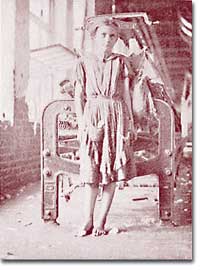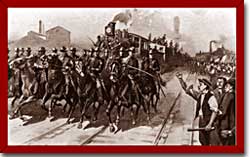37a. The Great Upheaval

Young cotton mill worker
A Spontaneous Eruption
It started with a 10% pay cut. When leaders of the Baltimore and Ohio Railroad Company ordered this second reduction in less than eight months, railroad workers in Martinsburg, West Virginia decided they had had enough. On July 16, 1877, workers in that town drove all the engines into the roundhouse and boldly declared that no train would leave until the owners restored their pay. The local townspeople gathered at the railyard to show their support for the strikers. A great showdown was on.
Strikes or other actions seen as disturbances are usually handled at the local level. The mayor of Martinsburg tried in vain to threaten the striking workers, but the crowd merely laughed and booed. The local police were far too insubstantial to match the numbers of the rabble. In desperation, the mayor turned to the governor of West Virginia for support. The governor sent units of the National Guard to Martinsburg to accompany the trains out of town by force of arms. There was little support for the effort among the Guardsmen, however, because a majority of them were railroad workers themselves. After two people were killed in the standoff, the Guard simply lay down their weapons and began chatting with members of the crowd.
Only when federal troops sent by President Hayes arrived did the trains leave the station. Even then they were sabotaged and harassed along their routes. Only one train reached its destination.
The Strike Spreads

The great railroad strike of 1877 began at the Baltimore and Ohio Railroad in Martinsburg, West Virginia.
The Martinsburg strike might have gone down in history as one of many small local strikes put down by force, but this time the strike spread. Soon other B & O units joined the Martinsburg strike. The movement spread into Pennsylvania, when workers on the Pennsylvania and Reading Railroads joined their compatriots. Pittsburgh is the gateway to the Midwest, and so the strike widened to that region.
The police, the National Guard, and the United States Army clashed with angry mobs throughout America. Throughout the land, wealthy individuals feared that the worst had finally come. A violent revolution seemed to be sweeping the nation.
But then it stopped. In some cases the strikes were ended by force. In others, the strikers simply gave up. After all, most workers were not trying to overthrow the government or the social order. They simply wanted higher wages and more time to spend with their families. The Great Upheaval was not the first strike in American History; it was the first mass strike to involve so many different workers separated by so much space.
What Did This Mean for America?

Railroad strike
Was it successful? From a distance, it seems to have failed. However, in many cases, workers did have their demands met. There is no telling how many future pay cuts were avoided because of fear of reprisal from the laborers. The Great Upheaval was spontaneous. There was absolutely no advanced planning, showing how many rank and file workers had the same concerns about quality of life, as well as the same anger at those who controlled the wealth. More than 100,000 workers had gone on strike, shutting down nearly half of the nation's rail systems.
When the strike ended in the first week in August, over 100 people were killed and a thousand more were imprisoned. Untold millions of dollars of damage was caused to rail lines, cars, and roundhouses. The fight was over, but America had not seen the last of the mass strike.






